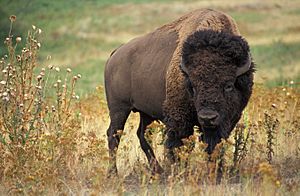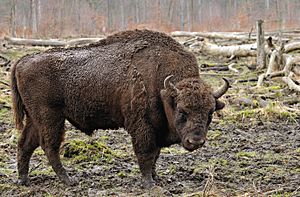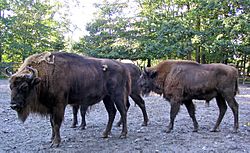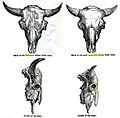Bison facts for kids
Quick facts for kids Bison |
|
|---|---|
 |
|
| American bison (Bison bison) |
|
 |
|
| European bison (Bison bonasus) |
|
| Scientific classification |
|
| Kingdom: | Animalia |
| Phylum: | Chordata |
| Class: | Mammalia |
| Order: | Artiodactyla |
| Family: | Bovidae |
| Subfamily: | Bovinae |
| Subtribe: | Bovina |
| Genus: | Bison Hamilton Smith, 1827 |
| Species | |
|
B. bison |
|
Bison are a large, even-toed ungulate. They are bovines, similar to cows. They are often called buffalo, but are not closely related to African buffalo or water buffalo.
Bison live in the northern part of the world. The American bison lives in North America where they formerly wander around the prairies in huge herds. The wisent lives in Europe. Bison can also live in rugged areas.
American
They are the biggest mammals in North America. There used to be as many as 30 million bison in the United States, but because of hunting, by 1890, only 1,000 bison were left. Through conservation efforts, there are now more American bison than there used to be, but still far fewer than there were before the 1800s.
European
European bison (wisent) tend to live in lightly wooded to fully wooded areas and areas with increased shrubs and bushes, though they can also live on grasslands and plains.
Taxonomy
They are classified in the subfamily Bovinae of the family Bovidae
- Genus Bison
- American bison (Bison bison)
- Wisent or European bison (Bison bonasus)
Life
They live to be about 20 years old and are born without their "hump" or horns, which both males and females have. After shedding their light colored hair, and with their horns, they are grown at 2 to 3 years of age, but the males keep growing slowly until about age seven. Adult bulls are very dominant in mating season. Adult bison usually have one or two baby bison.
Images for kids
-
Magdalenian bison on plaque, 17,000–9,000 BC, Bédeilhac grottoe, Ariège
-
A group of images by Eadweard Muybridge, set to motion to illustrate the movement of the bison
-
A bison charges an elk in Yellowstone National Park.
-
Photo from the 1870s of a pile of American bison skulls waiting to be ground for fertilizer.
See also
 In Spanish: Bisontes para niños
In Spanish: Bisontes para niños










